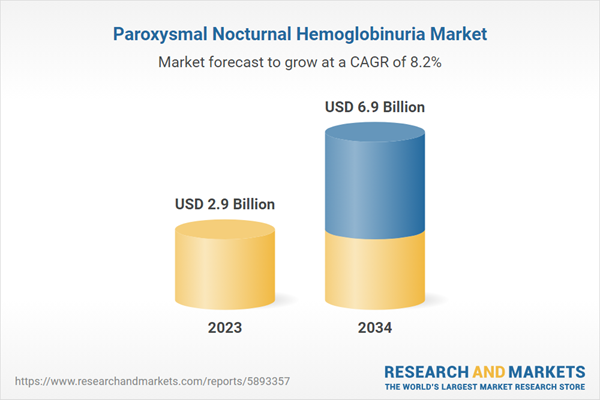The paroxysmal nocturnal hemoglobinuria market has been comprehensively analyzed in this report titled "Paroxysmal Nocturnal Hemoglobinuria Market: Epidemiology, Industry Trends, Share, Size, Growth, Opportunity, and Forecast 2024-2034". Paroxysmal nocturnal hemoglobinuria (PNH) refers to a rare and acquired hematological disorder characterized by the abnormal breakdown of red blood cells (hemolysis) and the presence of hemoglobin in the urine (hemoglobinuria). Some of the common symptoms associated with the ailment are fatigue, weakness, shortness of breath, pale skin, etc. PNH patients are also at an increased risk of thrombosis, which can result in pain, swelling, and organ damage. Various additional indications may include abdominal pain, fatigue, weakness, and, in advanced cases, bone marrow failure, that can lead to decreased production of other blood cells and a higher susceptibility to infections and bleeding problems. The diagnosis of paroxysmal nocturnal hemoglobinuria typically involves a combination of clinical evaluation, laboratory procedures, and specialized testing. Initially, a healthcare professional will review the patient's medical history as well as symptoms and conduct a physical examination. Numerous laboratory tests, such as a complete blood count, may reveal signs of hemolysis, including a low red blood cell count and elevated levels of lactate dehydrogenase (LDH). Flow cytometry is a key diagnostic test for PNH, as it detects the absence or reduced expression of certain GPI-anchored proteins on blood cells. Additionally, further genetic testing may be done to identify the specific mutation in the PIGA gene.
The rising cases of mutations in genes that affect the production of glycosylphosphatidylinositol (GPI) anchors, which are responsible for attaching various proteins to the surface of blood cells, are primarily driving the paroxysmal nocturnal hemoglobinuria market. Apart from this, the widespread adoption of numerous complement inhibitors, including eculizumab and ravulizumab, for reducing intravascular hemolysis, thereby leading to an increase in hemoglobin levels and a decrease in the need for blood transfusions, is also acting as another significant growth-inducing factor. Moreover, several key players are making extensive investments in R&D activities to develop small molecule inhibitors of the complement system, which could provide a simpler, more convenient treatment option compared to injectables. This, in turn, is further creating a positive outlook for the market. Additionally, the emerging popularity of multiparametric flow cytometry, since it offers enhanced sensitivity, specificity, quantification, subtyping, disease monitoring, and treatment guidance in the diagnosis as well as management of the ailment, is expected to drive the paroxysmal nocturnal hemoglobinuria market in the coming years.
This report provides an exhaustive analysis of the paroxysmal nocturnal hemoglobinuria market in the United States, EU5 (Germany, Spain, Italy, France, and United Kingdom) and Japan. This includes treatment practices, in-market, and pipeline drugs, share of individual therapies, market performance across the seven major markets, market performance of key companies and their drugs, etc. The report also provides the current and future patient pool across the seven major markets. According to the report the United States has the largest patient pool for paroxysmal nocturnal hemoglobinuria and also represents the largest market for its treatment. Furthermore, the current treatment practice/algorithm, market drivers, challenges, opportunities, reimbursement scenario and unmet medical needs, etc. have also been provided in the report. This report is a must-read for manufacturers, investors, business strategists, researchers, consultants, and all those who have any kind of stake or are planning to foray into the paroxysmal nocturnal hemoglobinuria market in any manner.
Time Period of the Study
- Base Year: 2023
- Historical Period: 2018-2023
- Market Forecast: 2024-2034
Countries Covered
- United States
- Germany
- France
- United Kingdom
- Italy
- Spain
- Japan
Analysis Covered Across Each Country
- Historical, current, and future epidemiology scenario
- Historical, current, and future performance of the paroxysmal nocturnal hemoglobinuria market
- Historical, current, and future performance of various therapeutic categories in the market
- Sales of various drugs across the paroxysmal nocturnal hemoglobinuria market
Competitive Landscape:
This report also provides a detailed analysis of the current paroxysmal nocturnal hemoglobinuria marketed drugs and late-stage pipeline drugs.In-Market Drugs
- Drug Overview
- Mechanism of Action
- Regulatory Status
- Clinical Trial Results
- Drug Uptake and Market Performance
Late-Stage Pipeline Drugs
- Drug Overview
- Mechanism of Action
- Regulatory Status
- Clinical Trial Results
- Drug Uptake and Market Performance
Key Questions Answered in this Report:
Market Insights
- How has the paroxysmal nocturnal hemoglobinuria market performed so far and how will it perform in the coming years?
- What are the markets shares of various therapeutic segments in 2023 and how are they expected to perform till 2034?
- What was the country-wise size of the paroxysmal nocturnal hemoglobinuria market across the seven major markets in 2023 and what will it look like in 2034?
- What is the growth rate of the paroxysmal nocturnal hemoglobinuria market across the seven major markets and what will be the expected growth over the next ten years?
- What are the key unmet needs in the market?
Epidemiology Insights
- What is the number of prevalent cases (2018-2034) of paroxysmal nocturnal hemoglobinuria across the seven major markets?
- What is the number of prevalent cases (2018-2034) of paroxysmal nocturnal hemoglobinuria by age across the seven major markets?
- What is the number of prevalent cases (2018-2034) of paroxysmal nocturnal hemoglobinuria by gender across the seven major markets?
- How many patients are diagnosed (2018-2034) with paroxysmal nocturnal hemoglobinuria across the seven major markets?
- What is the size of the paroxysmal nocturnal hemoglobinuria patient pool (2018-2023) across the seven major markets?
- What would be the forecasted patient pool (2024-2034) across the seven major markets?
- What are the key factors driving the epidemiological trend of paroxysmal nocturnal hemoglobinuria?
- What will be the growth rate of patients across the seven major markets?
Paroxysmal Nocturnal Hemoglobinuria: Current Treatment Scenario, Marketed Drugs and Emerging Therapies
- What are the current marketed drugs and what are their market performance?
- What are the key pipeline drugs and how are they expected to perform in the coming years?
- How safe are the current marketed drugs and what are their efficacies?
- How safe are the late-stage pipeline drugs and what are their efficacies?
- What are the current treatment guidelines for paroxysmal nocturnal hemoglobinuria drugs across the seven major markets?
- Who are the key companies in the market and what are their market shares?
- What are the key mergers and acquisitions, licensing activities, collaborations, etc. related to the paroxysmal nocturnal hemoglobinuria market?
- What are the key regulatory events related to the paroxysmal nocturnal hemoglobinuria market?
- What is the structure of clinical trial landscape by status related to the paroxysmal nocturnal hemoglobinuria market?
- What is the structure of clinical trial landscape by phase related to the paroxysmal nocturnal hemoglobinuria market?
- What is the structure of clinical trial landscape by route of administration related to the paroxysmal nocturnal hemoglobinuria market?
This product will be updated with the latest data at the time of order. Consequently, dispatch time for this product will be 7-10 business days.
Table of Contents
Table Information
| Report Attribute | Details |
|---|---|
| No. of Pages | 129 |
| Published | May 2024 |
| Forecast Period | 2023 - 2034 |
| Estimated Market Value ( USD | $ 2.9 Billion |
| Forecasted Market Value ( USD | $ 6.9 Billion |
| Compound Annual Growth Rate | 8.2% |
| Regions Covered | Global |









